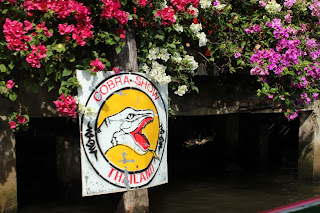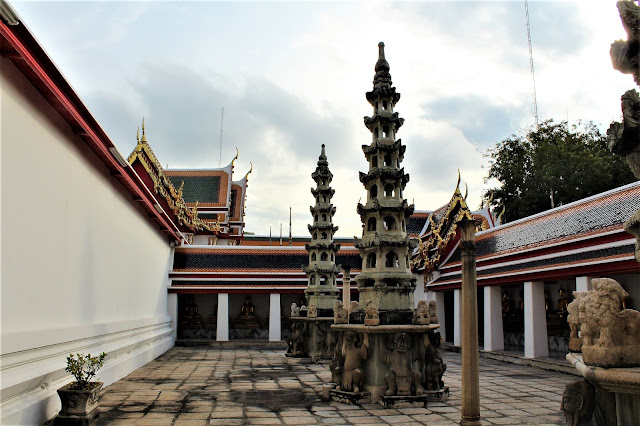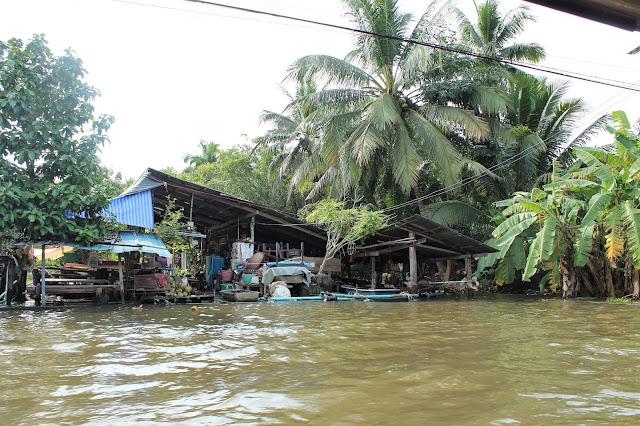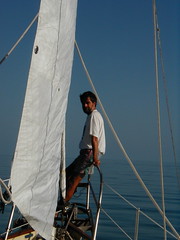A red eye flight from Shanghai
got us tired but excited to the international Bangkok
airport. A staff from AmiThai Travel was waiting for us, quite tired also! Our hotel
in Bangkok was the posh Royal
Orchid Sheraton: soon after arrival, we had a shower and went to bed…at
about 5am !!! At 10am ,
we were having breakfast with a magnificient view of the the Chao Phraya river!! Bangkok was welcoming us
with sunshine and 30C+ temperature - humidity there is always above 80%!!!!
First item on the itinerary was Jim Thompson house (a tong breaker for Thai people). This is the story of an American who fell in love with Thai culture and Thai silk in the 1940’s. Thai people are grateful to Thompson for putting the Thai silk on the world’s market (and thus, competing with Chinese silk).
His house, in the heart of Bangkok, was our introduction to Thai culture. The interior of the house was fabulous but picture taking was not allowed.
The gardens of the house were offering glimpses of Thai plants and orchids. It felt like a paradise! Small temples in honour of Buddha displayed flowers (marigolds, straw flowers) also ornated the gardens.
 A long-tail boat tour on the
A long-tail boat tour on the Exploring the riverside of
Wat Arun is the best known temple of
the country and it was our first visit to a Buddhist temple. Wat Arun, named after an Hindu God Aruna, existed in the 17th century but his distinctive spires were built in the early 19th century during the reign of King Rama II.
Dm
Families wearing the traditional costume were proudly displaying them and happy to have their photo taken!
Not only temples can be seen on the river edge...simple habitats also.
In a restaurant or in the evening, to relax after a very hot day, Chang beer was delicious!!!
Another day, another temple...Wat Pho was astonishing! A huge complex of 80,000 sq. meters and one of Bangkok oldest temples, it even existed before Bangkok was established as the capital of Thailand by Rama I. Indeed, in 1782, Rama I moved the capital from Thonburi (west bank of Chao Phraya) to the actual Bangkok site and ordered the renovation of the temple where his ashes are now enshrined. Wat Pho houses the largest collection of Buddha images (1,000) of the country and the 150 feet long reclining Buddha.
The temple complex has 2 main parts: one open to visitors with the buildings dedicated to Buddha. The other part on the opposite side of the street contains the residential quarters of the monks and a school.

Still in the huge complex of Wat Pho temple is a double walled cloister, Phra Rabiang, containing 400 images/statues of Buddha from Northern Thailand selected out of the 1200 images bought by King Rama I. Some standing, some sitting, are mounted on a gilded pedestal. While they stemmed from different periods in Thai history and therefore were of different colours and materials, Rama I had them covered with stucco and gold leaves to give them a similar look.
Larger towers of Phra at each corner of the courtyard are guardians of the four cardinal points.
Phra Ubosot is the main hall to perform buddhist rituals and the most sacred building of the complex. Here a Thai monk praying.
 Equally destined to educated the public, small rock gardens are dispersed through the complext with statues showing methods of massage or yoga positions.
Equally destined to educated the public, small rock gardens are dispersed through the complext with statues showing methods of massage or yoga positions. And while we are silently walking around buddha, the sound of coins falling in bowls resonnates through the temple: these 108 bronze bowls commemorate 108 characters of Lord Buddha.
And while we are silently walking around buddha, the sound of coins falling in bowls resonnates through the temple: these 108 bronze bowls commemorate 108 characters of Lord Buddha. One of the must-visits when in Bangkok is the Grand Palace, which has been the official residence of the Kings of Siam (and later, Thailand) since 1782.
The Palace was a popular sight when we visited in November because King Rama IX has just been cremated and his remains and ashes were taken to diverse places within the Grand Palace complex. Thais, who were now permitted to wear colours instead of mourning black or dark clothing, were there in great numbers. And our guide mentioned that the crowds were going to get larger as the day progressed. It was indeed very packed and difficult to move around. That day, we had to walk from the bus parking lot along the street, following the white walls of the Palace. Not a big distance but with the crowds and the heat, quite challenging at times. The Palace complex is 2,000,000+ square feet consists of numerous buildings, halls, pavillons set around open lawns, garden and courtyards.
We visited its most important sights, among them, the Temple of the Emerald Buddha or Wat Phra Kaew . Regarded as the most sacred Buddhist temple in Thailand,Wat Phra Kaew has over 100 buildings within the perimeter of the Grand Palace, covering a total area of over 94.5 hectares (234 acres). With its "old Bangkok style" architecture, the main temple of the Emerald Buddha is very elegantly decorated. The roof is embellished with polished orange and green tiles, the pillars are inlaid in mosaic and the pediments are made of rich marble, installed around 18th century. Its original construction was terminated in 1784. But the temple underwent several renovations, additions, and extensions under the reign of each King.
As for all sacred temples in Thailand, a strict rule of entry and conduct was applied at Wat Phra Kaew. Men must wear long trousers and sleeved shirts and shoes; women must wear long skirts or long pants. It is compulsory to remove the shoes before entering the temple (when in a crowd of hundreds of people, easier said than done but very well organised!) as a sign of respect of the Buddha., as is the practice in all other temples in Thailand. In general, while offering prayers before the Buddha image, the sitting posture should avoid any offensive stretching of feet towards the deity; the feet should be tucked in towards the back. In the case of the Emerald Buddha, we stood!and the Buddha could not be offended by our feet pointing towards him as the gate hid all of this.

 The Emerald Buddha is considered the symbolic protector of the Kingdom of Thailand. It is a figurine of the meditating Buddha seated in yogic posture, made of a semi-precious green stone (jade ). The Emerald Buddha is adorned with three different sets of gold seasonal costume; two were made by Rama I, one for the summer and one for the rainy season, and a third made by Rama III for the winter or cool season. The clothes are changed by the King of Thailand, or another member of the royal family in a ceremony at the changing of the seasons (hot season, rainy season and cold season).
The Emerald Buddha is considered the symbolic protector of the Kingdom of Thailand. It is a figurine of the meditating Buddha seated in yogic posture, made of a semi-precious green stone (jade ). The Emerald Buddha is adorned with three different sets of gold seasonal costume; two were made by Rama I, one for the summer and one for the rainy season, and a third made by Rama III for the winter or cool season. The clothes are changed by the King of Thailand, or another member of the royal family in a ceremony at the changing of the seasons (hot season, rainy season and cold season).This picture (taken by Gremel Madolora - on wikipedia) shows the Buddha in his winter clothing the way we saw it during our visit.
The history of this beautiful figure can be read in Wikipedia.https://en.wikipedia.org/wiki/Emerald_Buddha.
We feel fortunate to have been shown one of the most important figure of Thailand Buddhism.
There are many temples in Bangkok...and also many markets!

We were interested in the well known Damnoen Saduak Canal located in Ratchaburi, about 100 km south of Bangkok. Getting there was interesting in itself. as it presented us with non-touristic sites such as wood yards selling teak wood! and magnificent wooden Thai Spirit houses, often sighted in private homes temples to Buddha as shown below.
The Damnoen Saduak Canal was built at the end of the 19th century and was 32 km long. Soon after its construction was finished, more than 200 ancillary canals were dugged by villagers who soon found this means of transportation ideal to carry their goods from their gardens to markets.
We drove at a good speed and caught a glimpse of the villagers home living on the canal.
As we approached the Damnoen Saduak market area, boat traffic became more intense, with boats barely able to move and touching each other.
 And there are snake handlers ..for those tourists who would like to have their picture taken with cobras and other snakes (often imported from other countries just because they show well, such as this yellow Burmese python).
And there are snake handlers ..for those tourists who would like to have their picture taken with cobras and other snakes (often imported from other countries just because they show well, such as this yellow Burmese python).






















































No comments:
Post a Comment